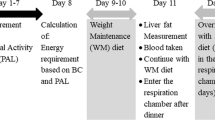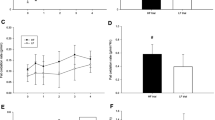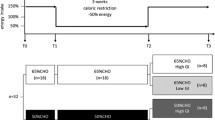Abstract
OBJECTIVE: To investigate physiological differences between habitual high-fat (HF) and low-fat (LF) consumers, which could influence the balance between energy expenditure and energy intake, and the potential for weight gain.
SUBJECTS: 16 young, lean males (eight HF and eight LF consumers; % energy from fat 44.3 and 32.0, respectively).
MEASUREMENTS: Habitual dietary variables (from FFQ), body mass index (BMI), body fat % (measured by impe-dance), resting metabolic rate (RMR) (indirect calorimetry), substrate oxidation and basal heart rate, postprandial thermogenesis and heart rate in response to a high-fat (low carbohydrate (CHO)) and high-CHO (low fat) challenge.
RESULTS: HF and LF (selected for their intake of fat) did not differ significantly in BMI or % body fat. HF had a significantly higher RMR (1624 vs 1455 kcal/d) and basal heart rate (66 vs 57 bpm) than LF. Differences in oxygen utilisation and heart rate were maintained over a 180 min period, following the high-fat and high-CHO challenge meals. HF had a significantly lower resting respiratory quotient (RQ) than LF and the differences in average RQ were significant over the 180 min examination period. HF had a significantly lower RQ response to the high fat (low CHO) than to the high CHO (low fat) challenge; this effect was not observed in LF. HF had higher total energy intake than LF and a higher absolute (but not %) intake of protein.
CONCLUSION: Significant differences in basal energy expenditure and fat oxidation between habitual HF and LF consumers have been observed. The contributions of energy intake and protein intake (g not %) remain to be determined. In this particular group of subjects (young adult males) a high energy intake characterised by a large fat component is associated with metabolic adaptations which could offset the weight inducing properties of a high-fat diet. These physiological differences may be important when considering the relationship between dietary-fat and obesity.
Similar content being viewed by others
Author information
Authors and Affiliations
Rights and permissions
About this article
Cite this article
Cooling, J., Blundell, J. Differences in energy expenditure and substrate oxidation between habitual high fat and low fat consumers (phenotypes). Int J Obes 22, 612–618 (1998). https://doi.org/10.1038/sj.ijo.0800635
Received:
Revised:
Accepted:
Published:
Issue Date:
DOI: https://doi.org/10.1038/sj.ijo.0800635
- Springer Nature Limited
Keywords
This article is cited by
-
Computational modelling of energy balance in individuals with Metabolic Syndrome
BMC Systems Biology (2019)
-
Fasting substrate oxidation at rest assessed by indirect calorimetry: is prior dietary macronutrient level and composition a confounder?
International Journal of Obesity (2015)
-
Appetite, Satiety, and Food Reward in Obese Individuals: A Behavioral Phenotype Approach
Current Nutrition Reports (2013)
-
Underreporting in obese inpatients undergoing a psycho-nutritional rehabilitative program
Eating and Weight Disorders - Studies on Anorexia, Bulimia and Obesity (2013)
-
Effect of organ and tissue masses on resting energy expenditure in underweight, normal weight and obese adults
International Journal of Obesity (2004)




